
35-3010RKA-03 Sample-Draw Detector • 11
5.
Repeat steps 3 and 4 for the remaining three mounting feet.
6.
Position the sample-draw housing on a vertical surface at eye level (4 1/2 to 5 feet
from the floor).
7.
Insert 1/4 in. or 5/16 in. screws through the slots in the mounting feet to secure the
housing to the mounting surface.
Connecting the Sample Lines to the Sample-Draw Detector
1.
Attach 1/4 in. O.D. rigid polypropylene or rigid Teflon sample tubing to the INLET
fitting.
CAUTION:
If you use flexible sample tubing (polyurethane is acceptable), use an appropriate
insert to seal the connection between the tubing and the INLET fitting.
2.
Place the opposite end of the tubing at the sampling area.
CAUTION:
Avoid loops or slumps in the incoming sample line. To reduce response time, keep the
incoming sample line as short as possible.
3.
Attach rigid sample tubing to the EXHAUST fitting.
4.
Route the opposite end of the tubing to an open area where the sample can safely
disperse.
Wiring the Sample-Draw Detector
WARNING: Always verify that the power source is OFF before you make wiring
connections.
1.
Turn off the controller.
2.
Turn off or unplug incoming power to the controller.
3.
Unlatch and open the housing door of the sample-draw detector.
4.
Guide a eight-conductor 18 gauge, shielded cable or eight 18 gauge wires in conduit
through one of the conduit hubs at the bottom of the sample-draw housing. If
necessary, use both hubs to bring the wires in making sure that all the wires for a
particular channel go through the same hub.
5.
Connect the cable to the sample-draw detector’s interconnect terminal strip as shown
in Figure 6.
6.
Close and latch the housing door of the sample-draw detector.
CAUTION:
Leave the cable shield drain wire insulated and disconnected at the sample-draw
detector. You will connect the opposite end of the drain wire at the controller.
7.
Route the cable or wires in conduit leading from the sample-draw detector to the
controller.
8.
Connect the drain wire to an available chassis ground at the controller. RKI controllers
typically have a ground stud that can be used to ground the cable’s drain wire.















































